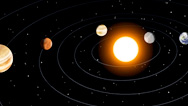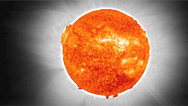Total Solar Eclipse Animation
- Teacher Resource
- Posted 12.17.05
- NOVA
Solar eclipses result from the alignment of the Sun, Moon, and Earth. Total solar eclipses — in which the Sun is completely blocked by the Moon — are a spectacular and rare sight to witness. In this animation adapted from NOVA, see why solar eclipses occur and observe a simulated total eclipse.
Permitted use:
![]() Download, Share, and Remix
Download, Share, and Remix


- Media Type: Video
- Running Time: 1m 13s
- Size: 3.7 MB
- Level: Grades 3-12
-
Log in to Teachers' Domain to download, share, rate, save, and match to state standards.
Source: NOVA "Eclipse of the Century"
Background
A total solar eclipse — in which the Moon completely covers the disk of the Sun — is a remarkable sight to witness. The geometry of the Sun, Moon, and Earth allows for either a solar or a lunar eclipse at least twice a year; however a total solar eclipse occurs only about once every year and a half. Total solar eclipses last only a short while and are visible only along the narrow path of totality, making these events unusual to observe.
As the Moon crosses in front of the Sun, a series of stages occur in the solar eclipse, as seen in this animated simulation. At first contact, the Moon just begins to cover the disk of the Sun. As the Sun becomes partially eclipsed by the Moon, it appears as if a bite has been taken out of it. The Moon continues to cross in front of the Sun, progressively covering more of it until the Moon completely obscures the Sun. This second stage, called second contact, is the period of totality. During totality, the Moon completely blocks the Sun, dusk falls, and the outer atmosphere of the Sun becomes visible as a wispy ring around the Moon. Totality lasts just a few minutes. As the eclipse continues, the Moon slowly reveals more of the Sun's disk.
During a solar eclipse, Earth passes through a portion of the Moon's shadow that consists of two parts: the umbra and the penumbra. The umbra is the dark center of the shadow where sunlight is completely blocked, and the penumbra is the outer part of the shadow where sunlight is only partially blocked. People on the portion of Earth that passes through the Moon's penumbra can see a partial solar eclipse. People in the narrow path of the umbra, however, can see a total solar eclipse.
Total eclipses are possible because, as viewed from Earth's surface, the disks of the Moon and Sun happen to appear almost exactly the same size. However, orbits are not circular, and as a result, variations occur in the distances between Earth and the Moon and Sun. These variations can create differences in apparent size; this in turn affects the length of totality and may at times produce an annular eclipse, in which a ring of the Sun's disc remains visible around the Moon.
To learn more about solar eclipses, check out Solar Eclipses.
To learn more about the total solar eclipse in 1991, check out Eclipse of the Century.
To learn more about the Sun, check out Characteristics of the Sun.
To learn more about the Moon's role in eclipses, check out Phases of the Moon.
Questions for Discussion
- The moon is 400 times smaller than the Sun, but 400 times closer to Earth than the Sun. What is the result of this coincidence?
- What is meant by the phrase "path of totality"?
- Describe the stages of a total solar eclipse.
Related Resources
-

Astronomy at Stonehenge?
An expert discusses the controversial question of whether Stonehenge was an astronomical observatory.
-

Tour the Solar System
Explore the planets, visit the moon, and gaze at the stars in this 3-D interactive model of the solar system.
-

Absolute Hot
Is there an opposite to absolute zero, the lowest possible temperature?





